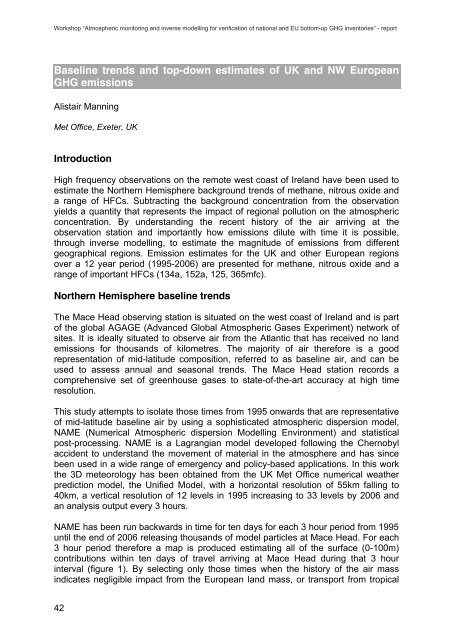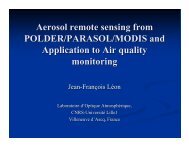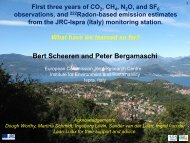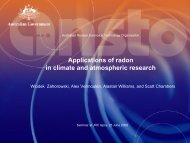download - Climate Change and Air Quality Unit - Europa
download - Climate Change and Air Quality Unit - Europa
download - Climate Change and Air Quality Unit - Europa
Create successful ePaper yourself
Turn your PDF publications into a flip-book with our unique Google optimized e-Paper software.
Workshop “Atmospheric monitoring <strong>and</strong> inverse modelling for verification of national <strong>and</strong> EU bottom-up GHG inventories” - reportWorkshop "Atmospheric monitoring <strong>and</strong> inverse modelling for verification of national <strong>and</strong> EU bottomupGHG inventories " - reportBaseline trends <strong>and</strong> top-down estimates of UK <strong>and</strong> NW EuropeanGHG emissionsAlistair ManningMet Office, Exeter, UKIntroductionHigh frequency observations on the remote west coast of Irel<strong>and</strong> have been used toestimate the Northern Hemisphere background trends of methane, nitrous oxide <strong>and</strong>a range of HFCs. Subtracting the background concentration from the observationyields a quantity that represents the impact of regional pollution on the atmosphericconcentration. By underst<strong>and</strong>ing the recent history of the air arriving at theobservation station <strong>and</strong> importantly how emissions dilute with time it is possible,through inverse modelling, to estimate the magnitude of emissions from differentgeographical regions. Emission estimates for the UK <strong>and</strong> other European regionsover a 12 year period (1995-2006) are presented for methane, nitrous oxide <strong>and</strong> arange of important HFCs (134a, 152a, 125, 365mfc).Northern Hemisphere baseline trendsThe Mace Head observing station is situated on the west coast of Irel<strong>and</strong> <strong>and</strong> is partof the global AGAGE (Advanced Global Atmospheric Gases Experiment) network ofsites. It is ideally situated to observe air from the Atlantic that has received no l<strong>and</strong>emissions for thous<strong>and</strong>s of kilometres. The majority of air therefore is a goodrepresentation of mid-latitude composition, referred to as baseline air, <strong>and</strong> can beused to assess annual <strong>and</strong> seasonal trends. The Mace Head station records acomprehensive set of greenhouse gases to state-of-the-art accuracy at high timeresolution.This study attempts to isolate those times from 1995 onwards that are representativeof mid-latitude baseline air by using a sophisticated atmospheric dispersion model,NAME (Numerical Atmospheric dispersion Modelling Environment) <strong>and</strong> statisticalpost-processing. NAME is a Lagrangian model developed following the Chernobylaccident to underst<strong>and</strong> the movement of material in the atmosphere <strong>and</strong> has sincebeen used in a wide range of emergency <strong>and</strong> policy-based applications. In this workthe 3D meteorology has been obtained from the UK Met Office numerical weatherprediction model, the Unified Model, with a horizontal resolution of 55km falling to40km, a vertical resolution of 12 levels in 1995 increasing to 33 levels by 2006 <strong>and</strong>an analysis output every 3 hours.NAME has been run backwards in time for ten days for each 3 hour period from 1995until the end of 2006 releasing thous<strong>and</strong>s of model particles at Mace Head. For each3 hour period therefore a map is produced estimating all of the surface (0-100m)contributions within ten days of travel arriving at Mace Head during that 3 hourinterval (figure 1). By selecting only those times when the history of the air massindicates negligible impact from the European l<strong>and</strong> mass, or transport from tropical42








